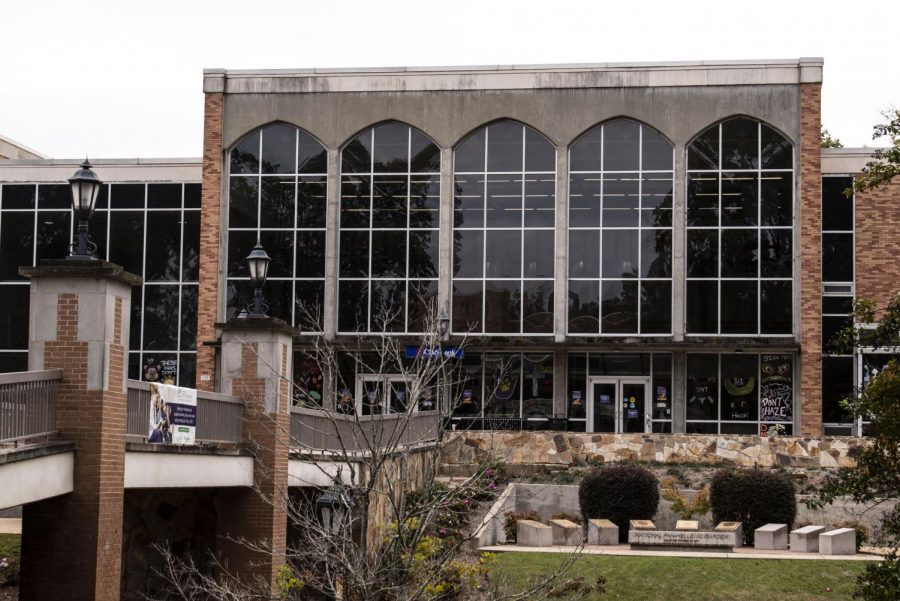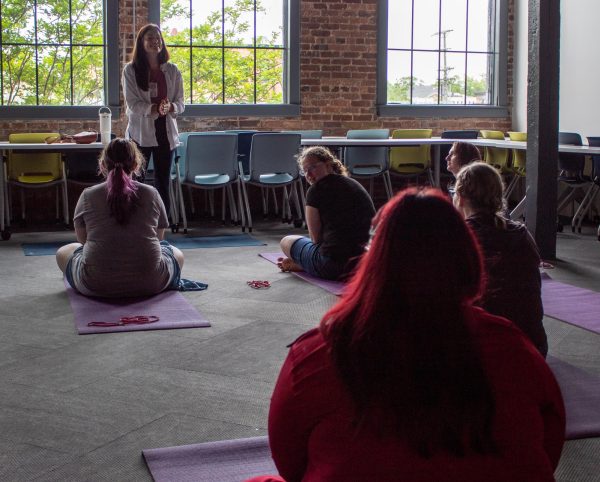Is UNA haunted? You decide.
The Guillot University Center (GUC) is known for having a weeping ghost by the name of Pricilla, who is said to have committed suicide after failing her classes and fearing disappointment.
October 29, 2020
The Flor-Ala sat down with Spirit Activities Coordinator of The University Program Council Catlin Przybysz to unearth campus’s haunted history. UPC will share these spooky legends during Leo’s Haunted Ghost Walk on Oct. 29 from 7 p.m. – 9 p.m.
Off Campus Bookstore
The tour begins with The Off-Campus Bookstore on the corner of Court Street and Irvine. Before the home was converted for retail, a family lived there in the 1920s. Molly, the daughter, played constantly with the family dog. One day, she saw her beloved pet foaming at the mouth. In attempt to comfort him, she reached out to pet him. The rapid dog locked his jaws into her hand and infected her with rabies—an incurable disease for the early 20th century. Molly died painfully in the upstairs bedroom.
Today, students see Molly playing in the daylight. She’s known to ask strangers, “Have you seen my dog?” In the 1980s, the brothers of Kappa Sigma turned the haunted space into their fraternity house. Molly’s room, they said, was always painfully cold.
O’Neal House
Alabama governor Edward O’Neal lived at 468 N. Court Street; the house next-door to Molly’s. Although they didn’t live there at the same time, Molly’s family allegedly lived in the 1920s whereas the O’Neal’s family history is well documented. Their Court Street home was built in the 1840s then acquired by their family in 1857. Edward O’Neal married Olivia Moore in 1838. She saw the house during its construction and knew she wanted to live there.
Mrs. O’Neal loved the house so much, she’s stayed there. Passersby describe her as a beautiful woman with long blonde hair. They often photograph her in the house’s right top window and report she seems friendly and hospitable.
The Guillot University Center
Before the Guillot University Center was built, O’Neal Hall stood in its place. One of UNA’s most well-known ghost stories took place here: the suicide of Pricilla. Though the motives of Pricilla’s suicide are unknown, rumors say she had failed all of her classes and feared disappointed her parents. A spicier version claims the affair Pricilla had with her professor had been found out. In both stories, she hanged herself in O’Neal elevator shaft.
Even though the GUC stands in O’Neal’s place, students report trouble with the elevators. Including lights flashing off and on and doors opening and closing. In the 1980s, a fraternity member locked up the building after a meeting but stopped because he heard a woman crying. Upon investigation, he saw a ghastly woman sobbing… Pricilla.
Norton Auditorium
When Norton Auditorium was built in the 1960s, a worker fell off of a high beam and died during construction. Although the exact identity of the man remains unknown, the Norton crew nicknamed him “George.” No one hears George talk, but he does prefer tricks over treats. He makes mysterious sounds throughout the building and plays designer with the auditorium’s lights. Tradition says that one night the Norton crew conducted some standard electrical tests before a show. They turned all the breakers off to change some lights. When they returned from a break, every light had turned on, despite the breakers off position.
Coby Hall
John Simpson built Courtland Mansion, Coby Hall’s original name, in the 1830s. During the Civil War, troops from both sides occupied the plantation home including Confederate General John Bell Hood. Coby remained a private residence until the 1990s when a generous benefactor bought the home and donated it to the university in memory of his wife.
Margret Patton Simpson, wife of the original builder John, haunts the hall. Legend says she hates raucous and disorder in her home, but she likes to come out for events parties.
The Old Phi Gamma Delta House
Before the house caught fire in August 2017, the Phi Gamma Delta house was haunted by a ghost named Ella. Conflicting reports debate whether Ella fell down the stairs accidentally or threw herself down the stairs intentionally. Members heard her screams at night and claimed she acted out when brothers brought their girlfriends home. No word on if she’s moved to haunt the new house; perhaps she likes having a place all to herself now.
Wesleyan Hall
Zebulon Pike Morrison built Wesleyan Hall, the first building on campus, in 1855. During the Civil War, it functioned as a makeshift hospital for wounded soldiers. When General Sherman and the Union occupied the building, townspeople kidnapped his drummer boy, Jeremiah, to prevent Sherman from burning Florence. When the townspeople returned him, Jeremiah had a fondness for Cypress Creek. One outing, he dove headfirst into the shallow water and drowned. Now, his ghost walks from Cypress Creek to Wesleyan and students see on campus him soaking wet. Sometimes staffs find wet footprints pacing up and down Wesleyan Hall even after the building has been empty for the weekend.
Willingham Hall
Willingham Hall originally men’s dormitory constructed as part of President Franklin D. Roosevelt’s Works Progress Administration in 1939. Before, Nicholas Hentz, a French native, operated the Locust Dell Academy, an all girl’s school, on the property in 1834. Willingham now houses humanities professor’s offices; sometimes they hear piano playing well into the night. Hentz, a talented pianist in life, is thought to be responsible.
Pope’s Tavern Museum
A block away from UNA, Pope’s Tavern Museum served as hospital during the Civil War just like Wesleyan Hall. The original building is thought to have finished construction in 1811, but it burned down and had to be rebuilt in the 1830s. Thirty-two soldiers died here during its time as a hospital and were buried in the old Florence Cemetery. Countless others underwent amputations and surgeries. When people tour the museum, they often report smelling a foul stench of blood.
The Coffee-Reisman House
Located at 618 N. Wood Avenue near the sorority dorms, the Coffee-Reisman House is home to two ghosts from different times. The house was built between 1888 and 1900 and home to Mark Reisman, one of the first Jewish merchants in Florence. He shocked the community when he accidentally killed himself while cleaning his gun. Reports say the blood stain is still visible and his ghost stands about six feet tall with dark brown hair.
The other spirit that haunts this house is the ghost of Eliza Coffee for whom Eliza Coffee Memorial Hospital is named. Eliza struggled her whole life with “flux,” another word for dysentery. She passed away at 25 from malaria while visiting North Carolina, but they say her spirit wandered back to her beloved Florence.












